The Jordanian Badia has suffered significant degradation as a result of prolonged, heavy livestock grazing and a lack of rain. In order to recover and preserve the grasslands for protracted production, projects must collaborate with local communities on restoring vegetation, while helping to lessen the vulnerability of livestock to drought and other consequences of climate change.
The Badia covers around 85 percent of the Kingdom's total area, according to experts. More than 3,500 underground wells and 90 million cubic meters of surface water are discharged annually into the Badia. Important water basins include the Disi Basin, the Dead Sea Basin, the Yarmouk Basin, the Zarqa Basin, and the Azraq Basin.
The region is additionally characterized by mineral resources, including limestone, sand, silica, volcanic sand, zircon, and phosphates, as well as basalt minerals, bentonite, chalk, copper, diatomite, dolomite, gold, gypsum, kaolin, and oil shale — each of which has several industrial applications.
Climate-related damagesThere is no question that the Badia region is being impacted by climate change. Rainfall patterns have altered significantly over the past 30 years, with droughts occurring more frequently and for longer periods of time. High and low temperatures have also changed noticeably over time.
Since it has been overgrazed for so long, the majority of the Badia is severely damaged. Grazing animals find the vast majority of these locations to be unappealing, characterized by only barren soil and scarce flora.
Since it has been overgrazed for so long, the majority of the Badia is severely damaged. Grazing animals find the vast majority of these locations to be unappealing, characterized by only barren soil and scarce flora. The already challenging desert existence for the Bedouin people who inhabit this area thus becomes substantially worse.
Due to increasing desertification, sandstorms are also becoming more frequent and can cause significant damage to plants. These climate changes all aggravate issues that were already severe in the Badia, such as water scarcity, desertification, and grazing degradation.
Grazing restrictionsThe Badia is well known for farming endeavors. The majority of its agricultural crops are vegetables — primarily tomatoes — while sheep make up 85 percent of local livestock. The problem of desertification in the Badia has been exacerbated by the shrinking of the vegetation cover due to the scarcity of rain and overgrazing, which has caused pastures to recede.
Success depends on engagement, and for the management of natural resources to be feasible in the long run, communities must actively participate in decision-making and take full responsibility for the restoration and maintenance of the land.
Since so many people depend on the Badia's delicate ecosystem, the government should impose grazing restrictions as one means of addressing these issues. This is an example of the international policies applied to diminish environmental degradation. Reseeding, planting, and resting the land can also help to slow deterioration.
Community buy-inSuccess depends on engagement, and for the management of natural resources to be feasible in the long run, communities must actively participate in decision-making and take full responsibility for the restoration and maintenance of the land.
This means that it will be necessary to engage closely with neighboring communities to assist them in setting up grazing committees that delineate boundaries in accordance with recognized grazing rights. Collectively, these committees can select appropriate areas for rehabilitation as a supporting community.
Because of their extensive local knowledge of the soil types, vegetation, and water availability, bedouin herders — the actual experts of the land — are encouraged to collaborate with specialists to develop workable management plans. These plans must specify where shepherds may pasture their animals based on seasonal conditions, and how many sheep should graze in a specific region at any particular moment. Furthermore, the committees that establish the grazing laws should include women from the local communities.
Learning from the pastIn order to maintain these pastures' ability to support themselves, a fund must be set up. The money will be mainly used for reserve management, which could involve yearly planting projects, and small dairy factories.
The way to help the local communities adapt to climate change is rehabilitation, which should be combined with careful management to maintain the production of grazing land
The establishment of cooperative agricultural associations was the main focus in the past. Unfortunately, these associations suffered greatly from poor administration, a lack of transparency, and, most importantly, institutional weakness. These flaws make it necessary to employ a different approach. Tribal associations, for example, could be employed to motivate efforts to advance agriculture, particularly best practices in grazing.
The way to help the local communities adapt to climate change is rehabilitation, which should be combined with careful management to maintain the production of grazing land. It is also important to regrow native plants that reestablish ecosystems, assist in the provision of fodder, maintain livestock breeds that are adapted to extreme drought, and sustain the soil by halting the motion of sands.
All these vital will increase resilience and lessen the vulnerability of local communities in the Badia to the consequences of climate instability.
Latest News
-
 Crown Prince chairs meeting to review programme on combating littering
Crown Prince chairs meeting to review programme on combating littering
-
 King congratulates Morocco monarch on football team’s 2025 Arab Cup win
King congratulates Morocco monarch on football team’s 2025 Arab Cup win
-
 US Senator Accuses Hamas and Hezbollah of Rearming
US Senator Accuses Hamas and Hezbollah of Rearming
-
 One Dead in Israeli Strikes on South Lebanon
One Dead in Israeli Strikes on South Lebanon
-
 Putin Ready to Talk to France’s Macron on Ukraine, Says Spokesman
Putin Ready to Talk to France’s Macron on Ukraine, Says Spokesman